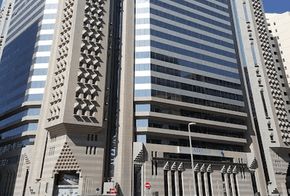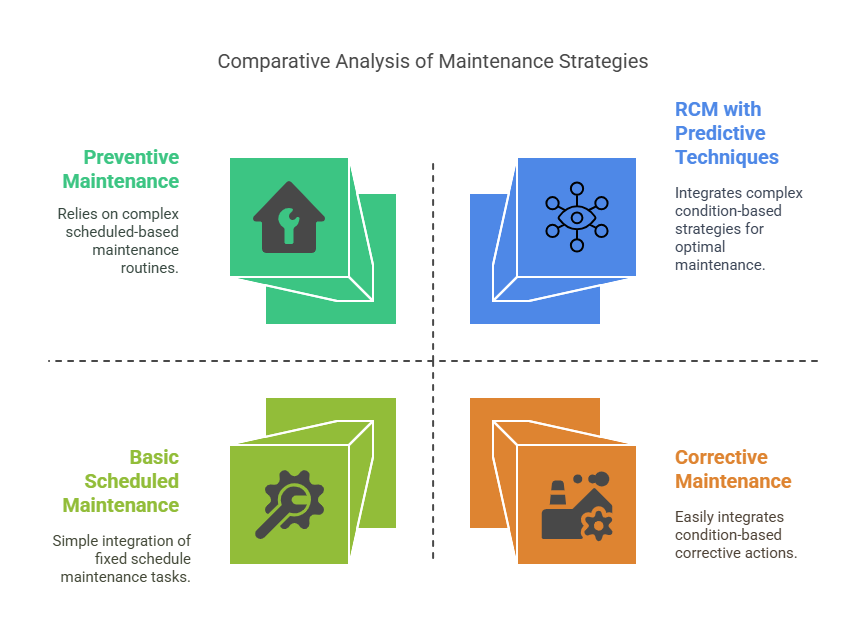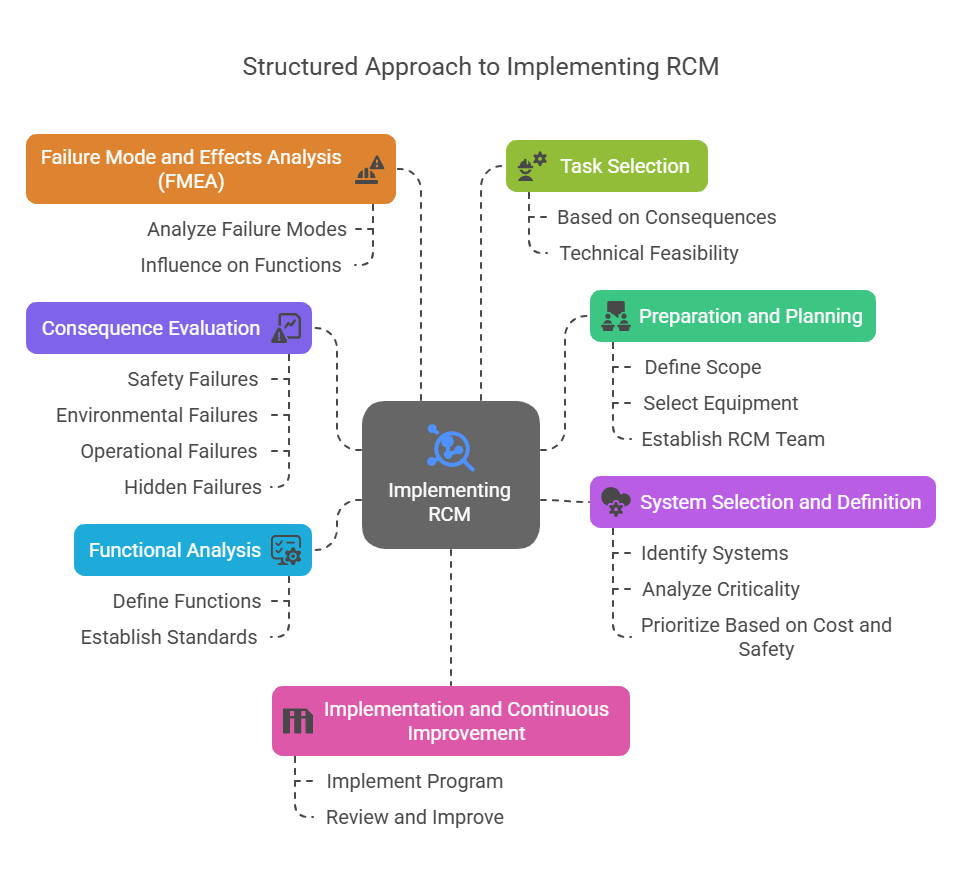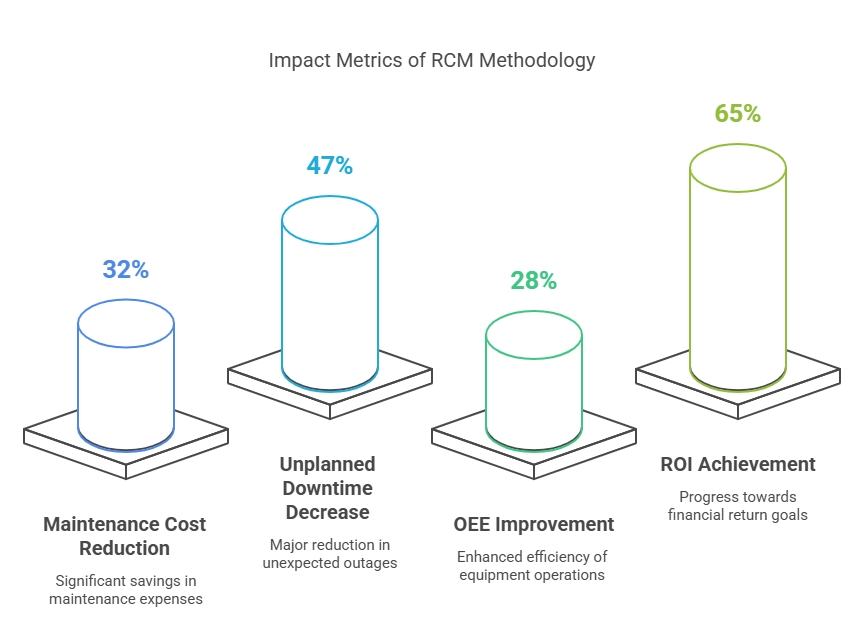- April 3, 2025
- Posted by: Velosi Author
- Categories: Asset Integrity, Insights

Reliability-Centered Maintenance (RCM) is a well-structured framework that revolutionizes how organizations develop and manage asset management and maintenance strategies. At Velosi Asset Integrity Limited, we have applied RCM techniques across vast industrial sectors to maximize equipment dependability, reliability and reduce maintenance costs. This article explores critical aspects related to the implementation of RCM.
What is Reliability-Centered Maintenance (RCM)?
Reliability-centered maintenance (RCM) is a preventive maintenance methodology that defines and optimizes system reliability. RCM identifies potential failure modes prior to their occurrence. Based on reliability principles, it identifies the most efficient maintenance activities for your assets and ensures that resources are allocated efficiently.
The primary goal of RCM is to maintain the function of equipment systems at the lowest cost feasible. This is quite different from the conventional maintenance approaches based on the running of assets only, instead emphasizing the upkeep of system functions necessary for critical operations.
By systematically addressing these questions, maintenance teams can develop comprehensive maintenance strategies according to their specific operational needs.
The Benefits of Implementing RCM
Organizations that properly implement RCM methodologies experience multiple benefits:
- Improved Reliability and Uptime
Reliability-centered maintenance (RCM) helps prevent failures and reduces the frequency of unplanned downtime, which enhances the overall equipment reliability and availability.
- Cost Reduction
RCM helps organizations to eliminate unnecessary maintenance tasks, minimizing their maintenance expenses by 20-30% while maintaining the same equipment reliability.
- Enhanced Safety
By identifying and addressing potential failure modes that could lead to safety hazards, RCM creates a safer working environment for personnel.
- Optimized Resource Allocation
Identifies and analyzes potential failure modes that could result in safety issues. RCM makes the workplace safer for employees.
- Extended Asset Lifespan
By addressing the root causes of failures and implementing appropriate preventive measures, RCM extends the useful life of capital assets.
Reliability-Centered Maintenance (RCM) vs. Other Maintenance Strategies
Understanding how RCM compares to other maintenance approaches helps organizations determine the best strategy for their needs:
Preventive Maintenance vs. RCM
Preventive maintenance relies only on fixed schedules based on time or usage, whereas RCM identifies maintenance activities based on failure consequences and actual failure patterns of the equipment.
Predictive Maintenance vs. RCM
Predictive maintenance is a subset of RCM. The RCM process may recommend predictive maintenance techniques where appropriate, but also includes other task types.
Corrective Maintenance vs. RCM
Corrective maintenance (run-to-failure) may be a conscious choice within an RCM program for non-critical assets where the cost of failure is low.
The RCM Implementation Process
Implementing RCM requires a structured approach:
- Preparation and Planning
Define the scope of the RCM program, select the equipment to be analyzed, and establish the RCM team.
- System Selection and Definition
Identify, analyze, and prioritize systems based on the levels of criticality, cost, and safety factors.
- Functional Analysis
Define the functions of each system and establish performance standards.
- Failure Mode and Effects Analysis (FMEA)
Analyze the potential failure modes and their influence on system functions.
- Consequence Evaluation
Determine the consequences of each failure mode, categorizing them as safety, environmental, operational, or hidden failures.
- Task Selection
Select appropriate maintenance tasks based on failure consequences and technical feasibility.
- Implementation and Continuous Improvement
Implement the RCM program and continuously review and improve the maintenance strategy.
Velosi Asset Integrity Limited’s RCM Approach
At Velosi Asset Integrity Limited, we’ve developed a comprehensive RCM methodology that integrates with our broader asset integrity management services. Our approach emphasizes:
- Industry-Specific Applications
We modify relative RCM techniques to maintain unique requirements of each industry, such as oil and gas, power generation, manufacturing, or infrastructure.
- Data-Driven Decision Making
Velosi utilizes advanced analytics and condition monitoring technologies to improve the effectiveness of RCM programs.
- Integrated Asset Management
The RCM approach integrates with other asset management strategies to form a holistic approach to asset performance management.
- Real-Time Optimization with VAIL-Plant®
Velosi’s advanced Asset Integrity Management software, VAIL-Plant®, enhances reliability-centered maintenance by Failure mode and effect analysis, risk-based maintenance, condition monitoring, and predictive analytics. The integrated software enables organizations to implement a proactive and cost-efficient RCM strategy, ensuring maximum operational excellence and asset reliability.
- Continuous Improvement
We establish processes for regular RCM program assessment and enhancement to allow for adaptation to new operational requirements.
RCM methodology with Velosi Supports:7-
– 32% reduction in maintenance costs
– 47% decrease in unplanned downtime
– 28% improvement in overall equipment effectiveness (OEE)
– 65% of targeted ROI
Common Challenges in Reliability-Centered Maintenance (RCM) Implementation
Despite its benefits, organizations often face challenges when implementing RCM:
- Resistance to Change
Maintenance teams accustomed to traditional approaches may resist the change to RCM methodologies.
- Resource Constraints
The initial implementation of RCM requires significant resources, including personnel time and expertise.
- Data Quality Issues
Effective RCM relies on quality data about asset performance and failure history, which may be lacking in some organizations.
- Sustaining the Program
Many organizations struggle to maintain the momentum of their RCM programs after the initial implementation.
Overcoming Reliability Centered Maintenance (RCM) Implementation Challenges
To address these challenges, organizations should:
- Invest in Training and Education
Ensure that maintenance teams understand the principles and benefits of RCM.
- Start with Pilot Projects
Begin with a limited scope to demonstrate success before expanding the program.
- Improve Data Collection Systems
Implement systems to collect and analyze the data needed for effective RCM.
- Establish Governance Structures
Create clear roles, responsibilities, and review processes to sustain the RCM program.
The Future of RCM
The evolution of technology leads to corresponding developments in Reliability Centered Maintenance (RCM) practices.
Integration with Industry 4.0
The implementation of RCM now combines IoT sensors, big data analytics, and artificial intelligence to improve predictive features.
Digital Twin Concept
Organizations are ready to utilize virtual models of physical assets to conduct failure simulations and improve their maintenance approaches.
Machine Learning Algorithms
Advanced algorithms are being developed to process enormous data sets and recognize patterns that human analysts would not detect.
Conclusion
To conclude, reliability-centered maintenance is a robust methodology for maximizing asset operational efficiency while optimizing maintenance strategies. RCM allows organizations to optimize their resource allocation by focusing on system function preservation rather than equipment condition assessment, resulting in better reliability and safety, together with cost-effectiveness and enhancements.
At Velosi Asset Integrity Limited, we aim to assist organizations in developing effective RCM programs that generate quantifiable enhancements to their asset performance. Our expert reliability engineers, together with asset integrity specialists, collaborate with clients to create customized RCM solutions that solve their critical operational challenges.
Contact Velosi Asset Integrity Limited today and explore how our RCM services can help your organization optimize maintenance strategies and improve asset performance.
Frequently Asked Questions About RCM
What types of assets benefit most from RCM?
RCM is most beneficial for critical assets where failure would have significant safety, environmental, or operational consequences. However, the principles can be applied to any asset system.
How long does it take to implement an RCM program?
The timeline for RCM implementation varies depending on the scope and complexity of the assets being analyzed. A pilot project might take 3-6 months, while a comprehensive program could take 1-2 years to execute.
Can RCM be applied to existing maintenance programs?
Yes, RCM can be applied to existing maintenance programs to optimize them. Many organizations use RCM to review and improve their current maintenance strategies.
How does RCM relate to ISO 55000 for asset management?
RCM follows ISO 55000 asset management standards to deliver a systematic methodology for efficiently managing assets.
Stay connected for more blogs!
Please contact us for more information and assistance.






